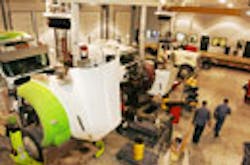As the recession forces cutbacks in personnel and hiring, fleets as well as dealerships continue to look for ways to "automate" or at least simplify many common maintenance shop procedures -- from paperwork to truck inspections.
"We're seeing a big uptick in business right now as companies try to minimize paperwork as a way to control staffing," Dave Lindeen, vp of Corcentric, told FleetOwner at the recent American Truck Dealers (ATD) annual convention. "Electronic invoice presentment and payment (EIPP) saves on paper costs, manpower, and other expenses typical with paper-based invoicing and payment systems."
Lindeen said the most immediate benefit for companies when they move to EIPP is the elimination by nearly half of the $21.86 per invoice handling cost. More important to fleets and dealerships, however, is that less manpower is needed to handle invoicing, payments, bookkeeping, and similar business necessities, he stressed.
As the recession forces cutbacks in personnel and hiring, fleets as well as dealerships continue to look for ways to "automate" or at least simplify many common maintenance shop procedures -- from paperwork to truck inspections.
"We're seeing a big uptick in business right now as companies try to minimize paperwork as a way to control staffing," Dave Lindeen, vp of Corcentric, told FleetOwner at the recent American Truck Dealers (ATD) annual convention. "Electronic invoice presentment and payment (EIPP) saves on paper costs, manpower, and other expenses typical with paper-based invoicing and payment systems."
Lindeen said the most immediate benefit for companies when they move to EIPP is the elimination by nearly half of the $21.86 per invoice handling cost. More important to fleets and dealerships, however, is that less manpower is needed to handle invoicing, payments, bookkeeping, and similar business necessities, he stressed.
Staffing has become a major issue for maintenance facilities of late, especially for truck dealerships. According to ATD, truck dealers have shed over 106,000 jobs since December 2007, yet at the same time, demand for maintenance services is going up. Bill Jackson, general manager of Peterbilt Motors Co., noted in comments earlier this year that the average age of the North American industry fleet is the highest it's been in the last 15 years. As a result, he said trucking is generating good parts and service business.
"Right now when it comes to tractors, 'useful life' is more important than 'average age,'" said Eric Starks, president of research firm FTR Associates. "The requirement to replace vehicles – freight demand – is not there. So orders for new equipment are going to be suppressed for a long while."
Dan Cleary, manager of technical services for Vehicle Inspection Services (VIS), told FleetOwner at the ATD convention that handling that demand with fewer people is precisely where automation can play a major role in maintenance shops.
"It's about using different devices to do more with less," he said, noting his company's VIS-Check system is a diagnostic machine that checks the brakes, steering and suspension of heavy trucks, then produces a safety and efficiency report to guide maintenance activities. He said shops can see a payback with the VIS-Check machine within a year if they service at least 10 trucks a day with it.
"One technician can use this device to conduct a truck inspection in 15 minutes, instead of two technicians taking an hour to two hours to inspect them manually," Cleary told FleetOwner. "That vastly improves the efficiency of the shop."
VIS is taking the same approach with another shop function: aluminum wheel cleaning. Instead of dedicating a technician to hours of laborious and hazardous work – the dust produced from sanding aluminum wheels is considered hazardous waste by the EPA – the new VIS-Polish self-contained machine does it without the need for human hands, according to the company.
"All the technician does is load the wheel into the system, program in what services the machine will perform, then walk away and do something else until it's finished," Scott Hough, market development manager, told FleetOwner. He said if dealership can polish and clean the aluminum wheels of just one truck per day, it'll pay for the cost of the VIS-Polish machine in about a year.
But it's not all about the money, Hough stressed. "This is a device that allows a shop to re-deploy technicians to cover more important works," he said. "It also automates a very time-intensive, menial task while eliminating exposure to hazardous materials. These are some of the efficiency and safety benefits we're trying to achieve with such automation."
About the Author
Sean Kilcarr
Editor in Chief
Sean Kilcarr is a former longtime FleetOwner senior editor who wrote for the publication from 2000 to 2018. He served as editor-in-chief from 2017 to 2018.
